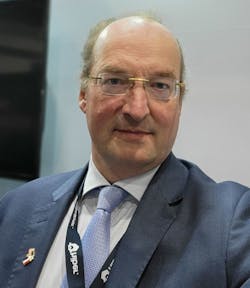OTC 2023: Hiber, WTS collaborate to improve remote monitoring technology
By Ariana Hurtado, Editor and Director of Special Reports
HOUSTON — A joint venture (JV) of Hiber and WTS Energy developed HiberHilo, a satellite-powered remote well-monitoring technology, in 2020. Since then, the companies have worked together on the installation, servicing and maintenance of the technology as it has rolled out to serve five supermajor oil and gas companies, including Shell.
HiberHilo is available in the US, Gabon, Nigeria, Mexico, Papua New Guinea, Romania, Trinidad & Tobago, and Brazil. Hiber is now also working with agents and partners in 12 further locations including Malaysia, UAE, Australia, Colombia, Saudi Arabia, India, Egypt, Oman, Angola and for projects in the North Sea, making HiberHilo available in more than 20 oil and gas producing countries.
Hiber boasts that HiberHilo delivers an all-in-one remote monitoring and management solution—hardware, software, and satellite connectivity—that is easy to install and use. The tool also includes digital pressure sensors and remote temperature monitoring devices that provide regular, reliable pressure and temperature data from any well, anywhere.
The technology has a wide range of applications and use cases for remote locations worldwide. These include production optimization and downtime reduction for artificially lifted wells and naturally flowing wells; injection optimization and downtime reduction for injector wells; and well integrity monitoring for producing, non-producing and gas storage wells.
HiberHilo also can be deployed for pigging planning and integrity monitoring for gathering or transmission pipelines.
Hiber partners with WTS Energy, a supplier in the oil, gas and renewable energy industries, on the installation, service and maintenance of HiberHilo.
Frederik Rengers, chairman of the board of WTS Energy, recently spoke with Offshore about the industry's need for this technology.
Moreover, he explained how other technologies failed to meet these industry needs.
"Most satellite connectivity systems are very expensive, difficult to install and integrate, and take a long time to fully realize real benefits," Rengers said. "In contrast, Hiber can connect your remote site within one day."
So, how did the company develop the remote well-monitoring technology? Rengers said the HiberHilo development began with the launch of a number of low-orbit satellites for IoT applications, and he noted that the team developed all the connectivity technologies in house.
"We saw our first commercial success with remote well integrity pressure monitoring and pipeline monitoring applications," he added. "We were also early adopters and believers in LoRaWAN technology and developed our own gateways and technologies to add this technology to the satellite connectivity to form an integrated solution."
The HiberHilo technology is specifically focused on satellite connectivity, pressure monitoring, well-integrity monitoring, methane emission monitoring and pipeline monitoring—all for remote locations. Furthermore, Rengers said the JV has expertise in applying cost-effective LoRaWAN technologies for oil and gas use cases.
"We are continually amazed by how many oil and gas assets are not connected with a real-time data link," he concluded.
Some of the JV's use cases include well abandonment and decommissioning monitoring, tubing pressure monitoring, gas-lift pressure monitoring, offshore production platforms, onshore locations, pipeline system monitoring and flow rate monitoring.
Rengers said there are several "noteworthy developments" his team is working on, including extreme temperatures in Canadian and Arctic locations, methane emission monitoring and feedback signals.
For more information, visit Hiber at OTC booth ET2369.
05.02.2023
About the Author
Ariana Hurtado
Editor-in-Chief
With more than a decade of copy editing, project management and journalism experience, Ariana Hurtado is a seasoned managing editor born and raised in the energy capital of the world—Houston, Texas. She currently serves as editor-in-chief of Offshore, overseeing the editorial team, its content and the brand's growth from a digital perspective.
Utilizing her editorial expertise, she manages digital media for the Offshore team. She also helps create and oversee new special industry reports and revolutionizes existing supplements, while also contributing content to Offshore's magazine, newsletters and website as a copy editor and writer.
Prior to her current role, she served as Offshore's editor and director of special reports from April 2022 to December 2024. Before joining Offshore, she served as senior managing editor of publications with Hart Energy. Prior to her nearly nine years with Hart, she worked on the copy desk as a news editor at the Houston Chronicle.
She graduated magna cum laude with a bachelor's degree in journalism from the University of Houston.




